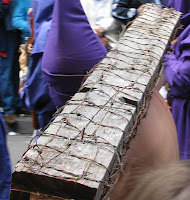 |
The Pentential Procession makes
its way down one of Quito's
colonial
streets, with the famous
Virgin Mary statue on an
overlooking hilltop. |
I am currently in Quito, Ecuador. I've been working at the Pontificial
Catholic University of Ecuador, giving classes to a group of MSc
Conservation Biology students here, and carrying out a variety of
research projects in the Andes. Soon, I'm off to the mountains for some
fieldwork, but right now it's Easter and I have a few days off.
Fieldwork abroad is a chance to learn a language and see something of other cultures. Good Fridays in Quito
are famous for the "Penitential Procession". It's calmed down a bit these days, but basically thousands of people process through the streets to demonstrate publically their devotion and to give penance for their sins. Many thousands more (including me) go to watch their suffering.
Some people dress as Jesus and drag along a heavy cross. THere is
usually a wide range of beards on offer (including a few recycled Santa
Claus versions), and an occasional Roman soldier accompanying Jesus,
whipping him from time to time. People from the crowd sometimes lend
Jesus a hand, but mostly the idea is that the person does it him- or
herself as penitence.
 |
Purple robes typify the procession.
|
Other people strap spiny cacti to their backs, wrap themselves in barbed
wire, whip themselves, drag chains behind them from their ankles. All
this is quite a spectable, with the public dashing in front of the
participants to take photos of their grimaces and/or blood. Film crews
interview people along the way
(like our London Marathon). The backdrop of the often steep streets of
colonial Quito--a UNESCO World Heritage Site--adds to the spectacle.
 |
TV crews broadcast the procession
to the nation. |

It is also a chance to get Catholic icons out of the churches and take
them through the streets. Mostly in this case, we are talking about
statues of Jesus carrying the cross, but the odd virgin also makes an
appearance. The whole procession ends, several hours after it starts,
with the famous statue of "Jesus of Great Power"
from the church of San Francisco.
Several times I have been to the equivalent in Mexico City. In many ways
it is very similar: lots of suffering and a big crowd (in the millions,
there). It has the extra attraction of a passion play, telling the
story of Jesus' crucification, and acted out in the streets by people
from the local community. It even ends with the real crucification of
Jesus and two theives on a nearby hill. Quito's version benefits from a
more intimate atmosphere.
 |
Some participants strap
spiny cacti to their
backs, others carry
heavy crosses. |
 |
Some people need to take some air from
time to time. |
 |
Could this "thief" be doing
penitence for actual robbery? |
 |
Jesus de Gran Poder is a
famous statue, not just because
of its
religious significance, but
also for its artistic merit. The
appearance
of this statue marks
the end of the procession |
In the past, Quito's Penitential Procession was a very bloody affair. People would
genuinely cut themselves, whip the skin from their backs, and burn
themselves with candles. Several of my friends in Quito refuse to go to
watch because of haunting memories of previous processions.
This year, I felt things were less extreme, though still pretty hard to
understand for me. But then I am not a religious person, and I go to
these things for cultural tourism. It reminded me that, for all its
trappings of the modern world, Quito still has a bit of the medieval
about it.
This "Jesus" dragged his cross for 4-5 hours through the
steep streets of Quito. His face tells the story.











